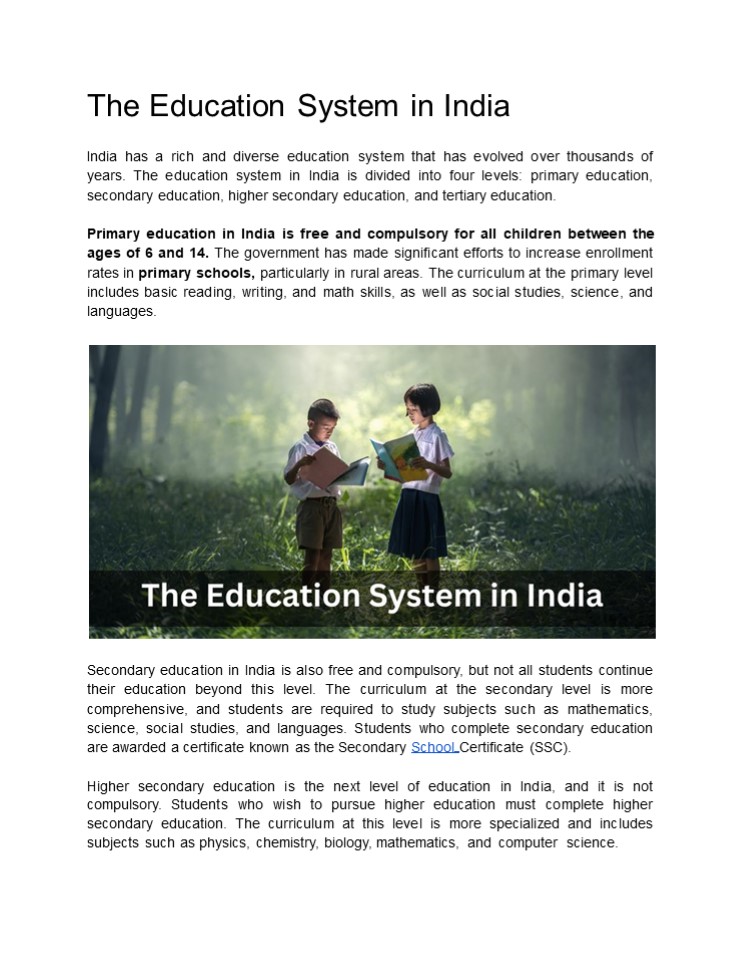The Education System in India - PowerPoint PPT Presentation
Title:
The Education System in India
Description:
India has a rich and diverse education system that has evolved over thousands of years. The education system in India is divided into four levels: primary education, secondary education, higher secondary education, and tertiary education. – PowerPoint PPT presentation
Number of Views:54
Title: The Education System in India
1
The Education System in India
India has a rich and diverse education system
that has evolved over thousands of years. The
education system in India is divided into four
levels primary education, secondary education,
higher secondary education, and tertiary
education. Primary education in India is free
and compulsory for all children between the ages
of 6 and 14. The government has made significant
efforts to increase enrollment rates in primary
schools, particularly in rural areas. The
curriculum at the primary level includes basic
reading, writing, and math skills, as well as
social studies, science, and languages.
Secondary education in India is also free and
compulsory, but not all students continue their
education beyond this level. The curriculum at
the secondary level is more comprehensive, and
students are required to study subjects such as
mathematics, science, social studies, and
languages. Students who complete secondary
education are awarded a certificate known as the
Secondary School Certificate (SSC). Higher
secondary education is the next level of
education in India, and it is not compulsory.
Students who wish to pursue higher education must
complete higher secondary education. The
curriculum at this level is more specialized and
includes subjects such as physics, chemistry,
biology, mathematics, and computer science.
2
Students who complete higher secondary education
are awarded a certificate known as the Higher
Secondary Certificate (HSC). Tertiary education
in India is provided by universities, colleges,
and technical institutes. The education system
at the tertiary level is divided into three
categories undergraduate, postgraduate, and
doctoral. Undergraduate programs typically take
three to four years to complete, and students are
awarded a Bachelor's degree upon graduation.
Postgraduate programs take one to two years to
complete, and students are awarded a Master's
degree upon graduation. Doctoral programs take
three to five years to complete, and students
are awarded a Ph.D. upon graduation. The
education system in India faces several
challenges, including a lack of infrastructure,
a shortage of qualified teachers, and a high
dropout rate. In recent years, the government
has made significant efforts to improve the
education system in India. The government has
increased spending on education and has
introduced several programs to encourage
enrollment and retention rates. The government
has also introduced several policies to improve
the quality of education, including the
introduction of new teaching methods and the use
of technology in education.
3
Despite the challenges, the education system in
India has produced many successful individuals
who have made significant contributions to
society. India has a large pool of talented and
highly educated individuals who are sought after
by employers around the world. The education
system in India is highly respected, and many
students from other countries come to India to
study. In conclusion, the education system in
India is diverse and rich, with a long and proud
history. The system faces several challenges, but
the government has made significant efforts to
improve it in recent years. The education system
in India has produced many successful
individuals who have made significant
contributions to society. With continued
investment and improvement, the education system
in India has the potential to become one of the
best in the world.































